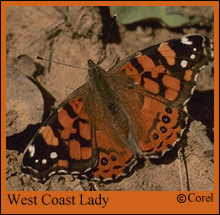West Coast Lady (Vanessa annabella)

Identification: Upperside is orange-brown with an orange bar at the leading edge of the forewing; hindwing with 3 or 4 blue submarginal spots. Underside with complex pattern; eyespots are obscured by other markings.
Life history: Males perch to watch for receptive females. Females lay eggs singly on upperside of host plant leaves; caterpillars eat leaves and live in a silken nest. Adults hibernate.
Flight: Many flights throughout the year in lowland California; two flights, summer and fall, in the Rocky Mountains; one flight in higher mountains.
Caterpillar hosts: Many plants in the mallow family (Malvaceae) including tree mallow (Lavatera), globe mallow (Sphaeralcea), bush mallow (Malvastrum), mallow (Malva), alkali mallow (Sida), checkerbloom (Sidalcea), and hollyhock (Althea).
Adult food: Flower nectar.
Habitat: Open places including weedy areas, gardens, roadsides, fields, foothills, chaparral, disturbed areas.
Range: Western North America from southern British Columbia south to Baja California Norte; south and east to Montana, Colorado, New Mexico, and Mexico. Strays to central Kansas, eastern North Dakota, and southern Ontario.
Conservation: Not required.
Management needs: Occasionally causes minor damage to hollyhock (Althaea) leaves.
The Nature Conservancy Global Rank: G5 - Demonstrably secure globally, though it may be quite rare in parts of its range, especially at the periphery.